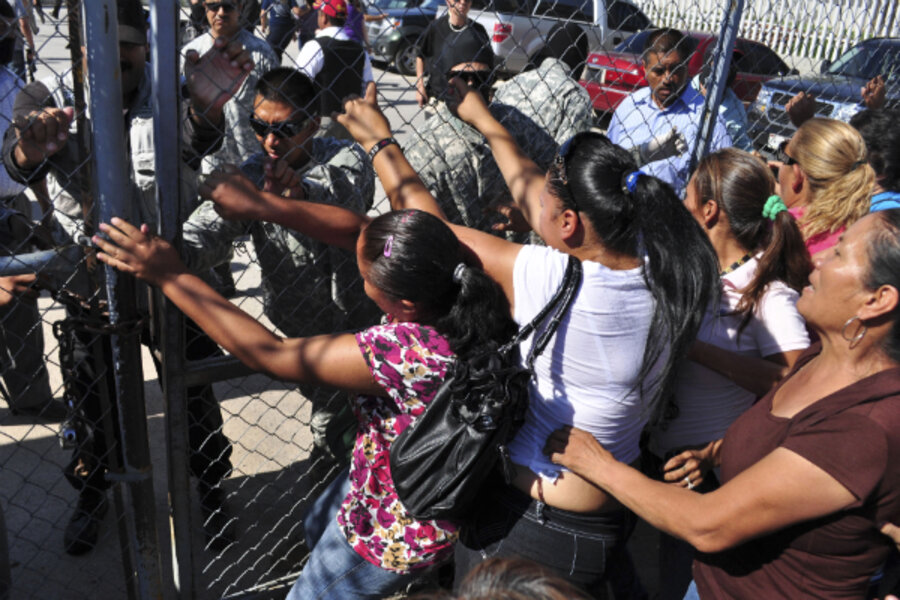Juarez prison riot points to lawlessness in Mexican system
Loading...
As Mexican authorities investigate the murder of 17 inmates in a Juarez jail, video footage from the scene has painted a picture of a cold-blooded killing, which officials seemingly made no effort to prevent.
Video taken from the jail’s security cameras, and released online by state authorities, shows the events leading up to the killing. A handful of guards are seen, just before the shooting began, leaving the hallway adjacent to the cell where 13 of the inmates were killed.
Although there is no sound, the video appears to show two of the shooters urging the guards to leave. Despite being armed, they seem to follow orders without resistance. Following their exit, the two shooters let at least four accomplices into the hallway, some of whom are carrying what appear to be assault rifles. At that point, the group opens the door to another room along the hallway, and begins firing at those inside.
State officials said that they have been unable to locate five of the weapons used in the massacre. However, an AR-15 assault rifle, thought to have been used in the shooting, was found.
According to the government, the shooters belong to the Aztecas, a gang working for the Juarez Cartel, while the victims, the Mexicles, are in the service of the Sinaloa Cartel. While some have interpreted recent declines in the levels of violence in Juarez as a sign that Sinaloa is steadily winning control of the city, the rivalry, which has killed thousands of people in Juarez over the past several years, appears to be as hotly contested as ever inside of the jail.
Furthermore as El Universal reports, Chihuahua state authorities are reporting that before the Monday night massacre, the Aztecas staged a party involving some 40 people in the prison facility. Four of those attending were teenage girls, one of whom spent the night in the jail with an inmate. This led officials to conclude that the party was an orgy, and that the girls were prostitutes.
However, in a declaration to authorities, at least one of the teenagers denied this, saying that, unusual venue notwithstanding, it was just a normal party, and that she and her friends were not paid to provide sexual favors.
While they haven’t said what sparked the massacre, officials have voiced the suspicion that it could be connected to the party.
The description of the massacre has also changed. Initial reports said that the deaths were the result of a riot and subsequent fighting between the two gangs. Instead, the video suggests that killings were closer to cold-blooded executions, and that the Aztecas gunned down members of the Mexicles without any immediate provocation.
The events in Juarez demonstrate the extent of inmate control over detention centers. While such scenarios are not uncommon in Mexico, typically such reports center on the highest-ranking jailed capos. Joaquin Guzman, alias "El Chapo's" stay in the Puente Grande prison is the iconic example, with the Sinaloa boss enjoying dalliances with prostitutes and female staff, throwing parties regularly, and employing many of the facility’s guards as his personal valets, before his eventual escape in 2001.
No comparably big fish was incarcerated in Juarez, yet the guards in the video appeared just as subservient, while gang members were apparently just as free to party as though they lived on the outside.
The incident in Juarez points to a longstanding problem in Mexican criminal justice: the abysmal quality of the prison system. The massacre in Juarez is just the latest mass killing in a Mexican prison. Nineteen people died in a prison riot in Tijuana in September 2008, the Aztecas killed 20 rival gang members at a state prison in Juarez in March 2009, 19 people were killed in fighting in a Gomez Palacio prison a few months later, and 23 were murdered in Durango in January 2010.
Other examples of prison deaths in smaller numbers, such as a May incident in Cancun noted by InSight Crime, are commonplace. Mass escapes have also grown more frequent, with 141 inmates stealing from a Nuevo Laredo detention center in a single incident last December.
Much of the difficulty stems from overcrowding: the prison system as a whole stands at 25 percent overcapacity, while the problem is even more severe in violence-plagued areas like Juarez. According to El Universal, the city jail where the Monday attack occurred housed 2,700 inmates, despite a capacity of just 850.
Demands to improve the quality of the penal system have been ignored by Mexican authorities, who seem to think such a task is hopeless. In response to a question about whether he could guarantee that there would be no more deadly incidents in the prison, Juarez Mayor Hector Murguia responded, “Only God can guarantee that, because given the conditions of the city jail, it’s almost impossible to control this type of event.”
--- Patrick Corcoran is a writer for Insight – Organized Crime in the Americas, which provides research, analysis, and investigation of the criminal world throughout the region. Find all of his research here.





